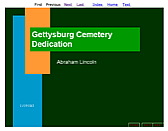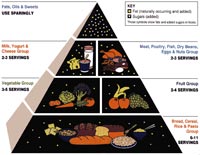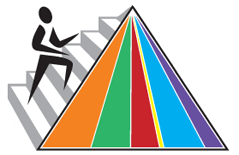 doesn't look like a factory:
doesn't look like a factory: 
<- Intro to Visual Communication home
Author (and architect) Richard Saul Wurman came up with the term "information architect" in 1975 as a way of explaining the skills a person needs to make vast quantities of data understandable. His book Information Anxiety describes how we're overwhelmed by information to the point that we may even feel anxious or depressed by how much we don't know. Think about all those computer programs you should learn—someday; all those things that your cell phone could do, if you only had the time to learn how to program it... and so on.
In Wurman's view the problem is too much raw data, too little understanding: lots and lots of facts don't necessarily add up to much in the way of meaning. A sobering statistic from the book: "A weekday edition of the New York Times contains more information than the average person was likely to come across in an entire lifetime in 17th century England."
With the rapid growth of the Internet, this flood of information has become a tidal wave that threatens to sweep away any hope we might have for making sense of it. We need to learn how to better deal with it. Not surprisingly, Information Architecture has become a popular Web buzzword.
Or, as Mad Stan said in Batman Beyond:
You think this is a joke? Look around, Batman! Society's crumbling! And do you know why?
Batman: Too many overdue books?
Mad Stan: Information overload, man! As a society we're drowning in a quagmire of vid-clips, e-mail, and sound bytes! We can't absorb it all! There's only one sane solution: blow it up!
To understand information architecture let's start by talking about architecture in general, the process of designing a building. One definition of architecture says it's the orderly arrangement of parts; another talks about frame or structure; others mention beauty and esthetic effect. Clearly there are various things that must be considered. Where do you start?
Let's back up even farther and point out that every building has a purpose to begin with. It may be a house, a store, an office building, or a barn. The architect must know this purpose before he/she can design any structure. No architect designs a generic structure, one with no specific intended use.
So it's no surprise that a house:  doesn't look like a factory:
doesn't look like a factory: 
That's a starting point.
But there's more: the architect must understand who will use the structure, and what their goals are.
It makes a huge difference, as you can see from these pictures of two houses:
A white house:  The White House:
The White House: 
In both cases the house is a place for a family to live. But the family who lives in the White House is very different in some ways from the family who lives in the white house. They have different goals that the house must help them achieve, including impressing the neighbors in a far more significant way than most of us worry about.
Understanding the purpose of a structure, who will use it, and what their goals are gives the architect some direction. Things like size, shape, number of rooms, construction materials and many other issues are largely determined by this. For example, 20 floors of steel and glass might be great for an office building, but would be totally inappropriate for a house. Other concerns like budget and esthetic issues related to the location (what will the neighbors think?) have a major influence on the work of the architect.
These are all things about the building that the architect must understand before beginning to work. In addition, he/she must understand structural engineering , the strengths of materials, qualities of light and sound, environmental concerns, and much more in order to know how to meet the needs of the building and client. Add to this a sense of beauty and craft, and you're ready to go.
I'd suggest that the information architect needs this same information and skill set.
__ what is the project? (book, flyer, website, billboard)
__ what is its purpose? to educate, to entertain, to convince someone to buy, to create an image)
__ who is the client? (type of business, philosophy, goals)
__ who is the audience? (age, education, gender, goals, etc.)
__ what materials do you have to work with? (paper, website, etc.)
__ what is the budget? (time and money)
Napoleon's March, one of Edward Tufte's most powerful example of how visuals can clarify complex information.
Google News gathers stories from more than 4,500 news sources in English worldwide, and automatically arranges them to present the most relevant news first. Topics are updated every 15 minutes using computer algorithms, with no human intervention.
Newsmap, a colorful site that visually reflects the constantly changing landscape of Google News information.
10x10 every hour collects 100 words and pictures that matter most on a global scale; runs with no human intervention, autonomously observing what a handful of leading international news sources are saying and showing.
 WordCount,
an interactive presentation of the 86,800 most frequently used English words;
won AIGA Award for Information Design. Which led to QueryCount (what
word would you look up first?).
WordCount,
an interactive presentation of the 86,800 most frequently used English words;
won AIGA Award for Information Design. Which led to QueryCount (what
word would you look up first?).
Using PowerPoint to visualize information: the good, the bad, and the ugly.
Recently the U.S. Food & Drug Administration (FDA) spent about four million bucks to renovate the old food pyramid that's supposed to help us understand the kinds and amounts of food we should eat to stay healthy.
The pyramid went from this:

to this:

No doubt it's more colorful and attractive, but is it doing its job? Does the new version make complex issues of how what we eat affects our health more understandable? The FDA thoughtfully has created a whole website to explain— take a look at MyPyramid.gov. At least one person thinks the architects goofed in their color choices, lack of icons, and use of vertical stripes to show the food groups. Jessie Scanlon and Slate offer alternatives in Four Servings of Design.
An excellent overview of the process of information design is A Unified Field Theory of Design by Nathan Shedroff. I recommend it highly. The books by Edward Tufte show how to present information clearly, accurately, and with great impact.
IDblog — information design weblog that covers all sorts of issues, from confusing graphs to simulating pregnancy.
Information Architecture for the Rest of Us — simple explanation, starting with "Pretend you are lost in the woods..."
Information Architecture for Websites — from defining goals to visual design.
[TOP]
OTHER WEEKS:
WK1 | WK2
| WK3 | WK4
| WK5 | WK6
| WK7 | WK8
| WK9 | WK10
| WK11 | WK12
| WK13 | WK14 |
WK15 | WK16
Visit Al's website, Interactive Design Forum | Send Al email